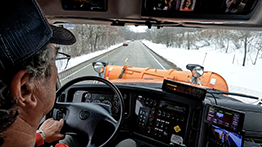
During harsh winter weather, snowplow drivers must work in the low-visibility conditions that keep other people off the road. These conditions can make it difficult to center the complex vehicles in the lane and avoid obstacles.
For nearly three decades, University of Minnesota researchers have worked in the lab and in the field—at times, literally shoulder-to-shoulder with drivers—to develop driver-assist technologies and improve safety and performance. This extensive line of research received this year’s Robert C. Johns Research Partnership Award (RPA) from the Center for Transportation Studies.
Professor Max Donath of the Department of Mechanical Engineering (ME) has shepherded the research, which included contributions from many ME researchers and students. The system was developed and refined under multiple research projects funded by MnDOT along with other sponsors and partners, such as the Minnesota Local Road Research Board.
Leveraging evolving GPS, radar, and related technologies, the system helps drivers with navigation and alerts them to potential hazards ahead. A display mounted to the dashboard has simple icons to show the truck’s lateral foot-by-foot position within the lane. “Operator feedback has been positive, showing that the system provides useful support,” Donath says.
MnDOT’s Shakopee Truck Station was the first to use the equipment and provide feedback to the U team. “One of the first things drivers noticed was that during the day, the lighting system worked great, but at two o’clock in the morning it was way too bright,” says Tim Murphy, the station’s assistant supervisor. Based on the feedback, researchers added a dimmer switch that lets drivers adjust the light volume. Researchers also made the light bar smaller so drivers could check the display moving their eyes only.
One example of the system in action occurred during a storm this past January that produced 50 mph winds and whiteout conditions. “We have pulled trucks off the road temporarily during a shift—drivers are told to pull over if they can’t see,” Murphy says. “But these guys have learned to rely on the system, so when it’s up and running, they say ‘No, I’m just watching the bars according to the U of M machinery.’”
The system helps drivers do their job while making driving less stressful. “I would recommend the system for other drivers and truck stations,” Murphy says.
The driver-assist system is used today in MnDOT and Dakota County fleets even as it is being further tested and refined for adoption throughout the state.
The next project, again sponsored by MnDOT, is underway. The goal is to begin to transition from a research focus to a production focus by preparing the system for a sustainable and scalable long-term, wide-scale deployment
—Pamela Snopl, MnLTAP senior editor
Learn more:
- Implementation of Lane Boundary Guidance System for Snowplow Operations (LRRB/MnDOT, in process)